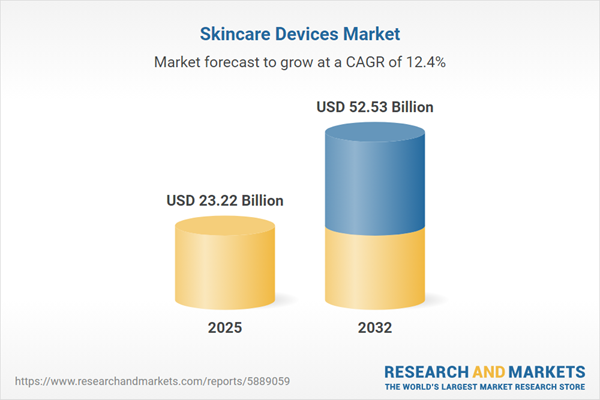Speak directly to the analyst to clarify any post sales queries you may have.
Senior executives in the beauty and wellness sector are navigating a rapidly evolving global market, where technological innovation, shifting customer expectations, and regulatory dynamics are reshaping the skincare devices landscape. This report provides a data-driven foundation for strategic decision-making on product development, supply chain optimization, and partnership investments.
Market Snapshot: Skincare Devices Market Size and Growth Trajectory
The skincare devices market grew from USD 20.66 billion in 2024 to USD 23.22 billion in 2025. Projected further, it is set to rise at a CAGR of 12.36% and is expected to reach USD 52.53 billion by 2032. Market growth is fueled by increasing demand for both professional and at-home solutions, digital transformation, and innovations across energy delivery and connected care. Stakeholders across all regions are adapting to evolving consumer needs and intensifying global competition.
Scope & Segmentation of the Skincare Devices Market
- Device Types: Cleansing brushes (Ionic, Rotary, Sonic), Dermaplaning tools (Manual, Powered), Iontophoresis devices (Continuous, Pulsed), Laser devices (Ablative, Non Ablative), Light therapy devices (Blue Light, Multi Wavelength, Red Light), Microcurrent devices (Handheld, Pen), Microdermabrasion devices (Crystal, Diamond Tip), Radiofrequency devices (Bipolar, Monopolar, Multipolar), Ultrasound devices (Face Massager, Skin Scrubber).
- Applications: Acne treatment (Mild, Moderate, Severe), Anti-aging (Collagen Stimulation, Skin Tightening, Wrinkle Reduction), Cellulite reduction, Depigmentation, Hair removal, Pore reduction, Skin rejuvenation (Pigmentation, Texture, Tone).
- End Users: Aesthetic clinics & spas (including medical spa), Dermatology clinics (including hospital settings), Home use (personal).
- Distribution Channels: Direct sales (Company website), Online retail (Brand website, Third-party marketplace), Specialty stores (Beauty specialty stores, Pharmacy).
- Geographies: Americas (United States, Canada, Mexico, Brazil, Argentina, Chile, Colombia, Peru), Europe, Middle East & Africa (United Kingdom, Germany, France, Russia, Italy, Spain, Netherlands, Sweden, Poland, Switzerland, United Arab Emirates, Saudi Arabia, Qatar, Turkey, Israel, South Africa, Nigeria, Egypt, Kenya), Asia-Pacific (China, India, Japan, Australia, South Korea, Indonesia, Thailand, Malaysia, Singapore, Taiwan).
- Leading Companies: FOREO AB, Panasonic Corporation, The Procter & Gamble Company, PMD Beauty LLC, NuFACE LLC, HomeSkinovations LLC, Tria Beauty Inc., LightStim Inc., Trophy Skin LLC, Theradome Inc.
Key Takeaways for Senior Decision-Makers
- Home-use skincare devices are no longer peripheral, driving significant share in both developed and emerging markets as convenience and personalization become top priorities for consumers.
- Integration of digital connectivity and IoT features is enhancing product adoption, allowing real-time progress tracking and remote consultations to reinforce brand loyalty and facilitate data-driven product improvements.
- Manufacturers are embracing modular and hybrid technologies, which allow for easier upgrades in line with evolving regulatory standards and diversification across applications, from acne management to anti-aging and skin rejuvenation.
- Strategic partnerships between beauty brands, medical device makers, and dermatological experts are accelerating technology transfer, market access, and the development of multifunctional, clinically validated solutions.
- Omni-channel distribution strategies are critical, as direct sales, specialty retail, pharmacy, and online marketplaces each cater to unique segments and play distinct roles in the consumer journey.
- Regulatory compliance is a key differentiator, especially in regions like Europe with stringent device validation requirements, which can foster competitive advantage for companies meeting higher clinical standards.
Tariff Impact and Supply Chain Implications
Following the introduction of United States tariffs on imported skincare devices in 2025, manufacturers have been forced to reassess cost structures and sourcing decisions. The resulting pressure has led many to explore regional assembly or nearshoring, transition to domestic manufacturing where viable, and adjust pricing strategies to preserve margins. Tariff-driven shifts are also sparking investments in flexible manufacturing and modular device architectures. Distributors and specialty retailers are revisiting supplier relationships and exploring alternative sources, while R&D priorities are adapting to ensure resilience amid ongoing trade policy changes.
Methodology & Data Sources
This report applies a robust multi-step methodology. Primary research comprises expert interviews with clinicians, manufacturers, and distributors. Secondary data combines regulatory analysis, clinical trial reviews, import-export data, and tariff schedules. Cross-validation techniques and quantitative modeling ensure accuracy and contextual relevance across all conclusions.
Why This Report Matters
- Gain actionable intelligence on the competitive landscape and product innovation cycles to support informed investment and go-to-market strategies.
- Understand the effects of regulatory change and tariff impacts on sourcing decisions, pricing, and margin management across key regions and end user segments.
- Leverage detailed consumer, application, and channel segmentation insights to maximize growth, operational resilience, and brand equity.
Conclusion
Senior decision-makers can leverage this report to anticipate market shifts, optimize product portfolios, and develop partnerships that create sustainable value. By focusing on dynamic technology adoption, consumer-centric design, and regulatory alignment, industry leaders will be well-positioned to succeed in the evolving skincare device market.
Additional Product Information:
- Purchase of this report includes 1 year online access with quarterly updates.
- This report can be updated on request. Please contact our Customer Experience team using the Ask a Question widget on our website.
Table of Contents
3. Executive Summary
4. Market Overview
7. Cumulative Impact of Artificial Intelligence 2025
Companies Mentioned
The companies profiled in this Skincare Devices market report include:- FOREO AB
- Panasonic Corporation
- The Procter & Gamble Company
- PMD Beauty LLC
- NuFACE LLC
- HomeSkinovations LLC
- Tria Beauty Inc.
- LightStim Inc.
- Trophy Skin LLC
- Theradome Inc.
Table Information
| Report Attribute | Details |
|---|---|
| No. of Pages | 183 |
| Published | October 2025 |
| Forecast Period | 2025 - 2032 |
| Estimated Market Value ( USD | $ 23.22 Billion |
| Forecasted Market Value ( USD | $ 52.53 Billion |
| Compound Annual Growth Rate | 12.3% |
| Regions Covered | Global |
| No. of Companies Mentioned | 11 |









